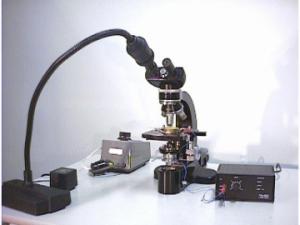He-6 Brownian Motion
Aim
To demonstrate Brownian Motion of an oil paint solution.
Apparatus
- Oil Paint Solution
- Microscope slide with well
- Microscope with camera attachment
- TV camera and monitor

Brownian Motion Setup.
Description
An important piece of evidence for the atomic theory was discovered by the biologist Robert Brown while observing pollen grain suspended in water. The unbalanced forces exerted by the the surrounding medium on a small but macroscopic body lead to a random motion of the body in question. Estimates of the atomic size have been made from a study of the resultant motion.
The demonstration consists in the observation of the brownian motion of suspended paint particles in a water solution. The setup requires the oil immersion objective, dark field illumination and the camera attachment.
A glass slide containing a hemispherical depression is filled with a dilute solution of gambauge paint. The correct concentration will be evident by the number of particles and their size as observed under high magnification. The dark field condensor is used with a single drop of oil immersion fluid.The condensor stage is raised until contact with the microscope plate is made by the oil. The condensor is then lowered slightly. Viewing through the binocular eyepiece focus is achieved and the stage is X-Y shifted to an appropriate region of interest. Once this has been accomplished the eyepiece is replaced with the wide field eyepiece and the camera focussed on the same image.